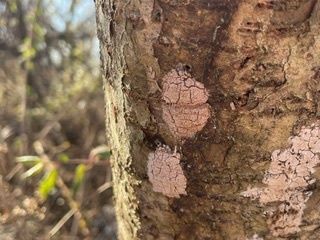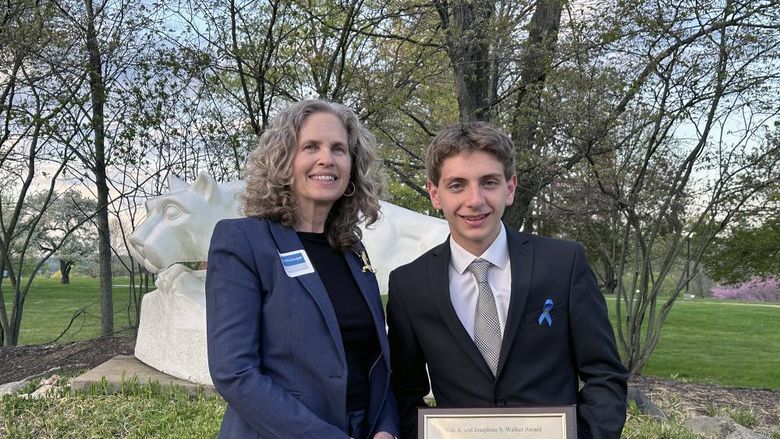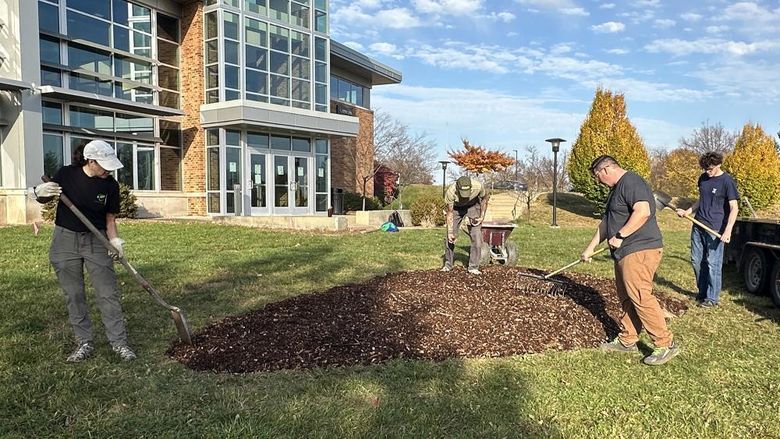
Light brown, flat spots on tree trunks around the Penn State Beaver campus are egg masses of the spotted lanternfly, an invasive species of insect that are drawn to the tree-of-heaven.
MONACA — By now many Pennsylvanians are familiar with the spotted lanternfly, an invasive insect that has spread across the state, besieging outdoor gatherings and causing people to swat and stomp their way through the outdoors in the late summer and early fall.
But are these pesky pests as pernicious as they were initially believed to be? Could there be a benefit to having the spotted lanternfly around?
That’s what Penn State Beaver Assistant Professor of Biology Dr. Autumn Sabo is trying to determine through a research project taking place on the Beaver campus. Aided by student research assistant Mallory Nichol, Sabo is studying a possible benefit to the spotted laternfly being in Pennsylvania.
The spotted laternfly is native to parts of China and Vietnam. They are attracted to certain trees, especially Ailanthus altissima, commonly known as the tree-of-heaven. The tree-of-heaven is also invasive and is native to northeast and central China and Taiwan. The trees will overtake forest edges, choking out native species.
There has been concern about the spread of the spotted lanternfly and what it may mean for domestic crops here, including apple and peach trees and grapevines.
According to Sabo, it makes sense that the lanternfly would gravitate toward the tree-of-heaven because they are native to the same area. “The spotted lanternfly’s favorite food is tree-of-heaven,” Sabo said.
And that could be a good thing.
If the spotted lanternfly sticks mostly to the tree-of-heaven, it may prevent them from destroying other crops. The spotted laternfly causes damage to the trees where they make their home. One of the things they do is eat the sap of the trees, Sabo said, which stresses the trees.
Sabo’s hypothesis is that the spotted lanternfly will stick mainly to the tree-of-heaven thereby leaving other trees and crops alone, and that the damaging effect the lanternflies will have on the tree-of-heaven will lessen the spread of the tree. Essentially it could be a case of one invasive species controlling another.
Nichol said she has marked 51 trees of heaven growing on the Beaver campus. She counted the number of adult spotted laternflies on the trees in the fall. She said there were some trees that had more than 100 adults on them. Now she has identified which of the trees have spotted lanternfly egg masses on them, and how many masses are on each tree.
Nichol said people can confuse lichen on trees with spotted lanternfly egg masses. The color of the mass is the easiest way to tell the difference, she said. Lichen tends to be gray or a greenish color while the egg masses are more of a khaki or brown color.
Next, they will study the trees over time to see what kind of damage the spotted lanternflies cause to those trees.
“I’m kind of hoping that when the eggs are laid on (the trees), and the nymphs and adults develop on them that there will be enough damage to the trees that it will slow down the growth of the tree-of-heaven,” Sabo said. “So, I’m asking that same question that a lot of people ask with the spotted lanternflies and desirable trees, ‘Are they damaging them? How much damage are they causing?’ But my hope with the invasive tree-of-heaven is that it’s a lot. Usually, people are hoping for no damage.”
As of now, Sabo doesn’t have an end date for her research based on the nature of the study and the need to watch the lanternflies and trees over an extended period of time.





